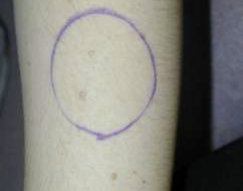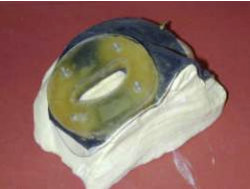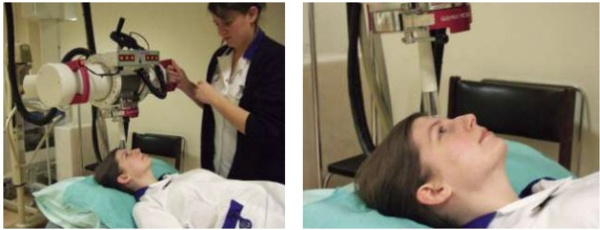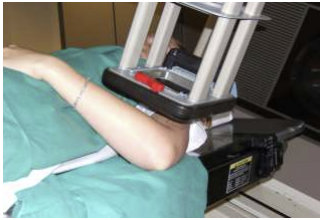Skin conditions
Radiotherapy for your skin at Velindre Hospital
This booklet will help you understand what will happen when you come to Velindre hospital to have radiotherapy treatment to your skin.
The booklet will explain how your treatment is planned and given. It will discuss side effects you may have and will tell you how to get more information and support.
A glossary is provided at the front of this booklet to help you understand any words that you may find unfamiliar.
Contact telephone numbers are given at the end of the booklet.
We hope this answers your questions. Please ask us if you have other questions that we have not covered.
Smoking is not allowed within the grounds and inside Velindre Hospital. If you need help giving up please ask us.
Glossary of terms
Antibiotic drops - drops that will help stop infections in your eye
Electrons and X- Rays - types of radiation
Impression - a copy of the shape of your face so a mask can be made
Local anaesthetic - drops that will numb your eye and stop you feeling any discomfort in your eye
Clinical Oncologist - the consultant doctor responsible for your treatment
Therapeutic radiographer - a person who will plan or give radiotherapy treatment
Skin Specialist Radiographer – plans your radiotherapy treatment
What is radiotherapy?
Radiotherapy is a treatment for cancer using radiation. The radiation is high energy X-rays or electrons.
How does radiotherapy work?
It works by damaging any cancer cells and stops the cancer cells dividing properly, so they are destroyed. Normal cells are also affected by radiotherapy, but are able to recover.
Radiotherapy team looking after you
The doctor responsible for your care is called a Clinical Oncologist. He or she, or one of their team will prescribe your radiotherapy treatment. The therapeutic radiographers will give you your treatment.
Velindre is a teaching hospital so your team may include a student radiographer, student nurse or a medical student. If you don't want a student present during your clinic or treatment appointment, please tell your doctor or radiographer.
We will ask your name, address and date of birth every time you come to the radiotherapy department. This is because our staff are trained to double check your personal details to avoid any confusion.
There are Information and Support Radiographers available to provide information, advice and support to you and your family. You or your family can speak to them by telephone (the phone number is on page 12). Or you can ask to see them during any of your appointments.
Transport to and from Velindre
Hospital transport is available but most people use their own transport. If you decide that you would like to use hospital transport, please give us as much notice as possible to arrange this for you. There is a high demand for transport so you will need to be prepared to wait for some time to be picked up and taken home. Spaces are limited so please consider travelling alone. Some local support groups can also arrange transport (see contact numbers on page 12). Also patients on particular benefits can claim travelling expenses, please ask when you come for your treatment.
How many treatments will I need?
You doctor will tell you how many treatments you need. You could have between one to ten treatments, or it may be more. Radiotherapy is given once a day, Monday to Friday. You may start your treatment on any day of the week.
Planning your radiotherapy
Radiotherapy is planned for each patient individually. Your first visit will be an appointment in the planning department. This is at the front of the hospital. Your doctor or the skin specialist radiographer will look at the area of your skin that needs treatment. He / she will explain your treatment and tell you about the side effects you may experience. They will also ask you to sign a consent form. Please ask any questions or discuss any worries you have.
Your doctor or skin specialist radiographer will use a marker pen (like a felt-tip) to draw around the area on your skin that needs the radiotherapy treatment.
 Picture of treatment area drawn on skin
Picture of treatment area drawn on skin
It is very important that you don’t wash the marks off so when you come for your treatment we can easily see where to treat you.
Treatment masks
If the area of your body that needs treatment is uneven, such as your nose. We may need you to wear a mask. This will be specially made to fit you. We will ask you to come to the mould room in our planning department to have your mask made.
The radiographers in the mould room will apply a special cream over the area the doctor has marked. This may feel a bit cold. A second cream is then put on top. It will ‘set’ in a couple of minutes. The radiographer will take this ‘mask’ off and you can go home. This impression is used to make the mask you will wear for your treatment.
 Face Impression
Face Impression
 Small mask read to wear
Small mask read to wear
Treatment near your eyes
If you need treatment to one of your eyelids or an area very close to your eye, we need to protect your eye from the radiation. To do this we use an internal eye shield which is like a large contact lens.
To fit the internal eye shield we will numb your eye first using drops that contain a local anaesthetic. The eye shield will be carefully placed over your eye (similar to a contact lens). This is left in place while you have your treatment. This may feel strange and uncomfortable but will not hurt.
Your radiographers will remove the eye shield after treatment. We will put some antibiotic drops in your eye and cover it with a small dressing to stop any dust entering your eye (your eye will be numb so you wouldn’t feel the dust).
Please keep this dressing on for at least one hour. It would be dangerous to drive or operate machinery with the dressing on. Please wait until the sensation returns to your eye.
Starting your treatment
If you have not had a mask made, you may start your treatment on the same day as your planning appointment. If this is not possible, we will give you an appointment to start your treatment in a few days after your planning appointment.
The radiographers who treat you will make your appointments. We try to be flexible and give you a time to suit you. But the treatment machine may be busy and this may not be possible.
Please let us know if you have any special needs that may affect your appointments, such as:
- needing transport
- having any other treatment (chemotherapy for example)
- personal difficulties (such as caring responsibilities)
During your first treatment
On your first treatment appointment, we will ask you for your consent for treatment again.
There are two machines that you may have your treatment on. If you are having X-Ray treatment you will be treated on a machine called DXR. If you are on DXR, please give your name to the receptionist in the out-patient department at the front of the hospital when you arrive for treatment.
If you are having electron treatment, your machine will be a linear accelerator or LA for short. Please go to the radiotherapy department entrance at the back of the hospital and give your name to the receptionist there.
In the treatment room you will lie on the treatment bed in a comfortable position. Your radiographers will position the machine in line with your marks. The radiographers leave the room to switch the machine on. They watch you carefully on television monitors. If you need them to come in while the machine is on, you can wave your hand. They will switch the machine off then come in to you. The treatment can be restarted when you are comfortable again.
Your treatment only takes a few minutes and you will not feel anything. We play music to help the time to pass. You are welcome to bring your own CDs.
The DXR machine is quiet when it is on. It may lightly press on your skin. This should not be painful.
 Having treatment on DXR
Having treatment on DXR
The LA machine makes a buzzing noise when it is on. It will not touch your skin but will come quite close to you.
 Having electron treatment on a linear accelerator
Having electron treatment on a linear accelerator
Treatment side effects
Radiotherapy causes a skin reaction; the area that we treat may become red and itchy. If this area has a scab, it may bleed a little. Please tell your radiographers if you are worried about your skin reaction they will advise you hope to look after your skin during your treatment.
If the area around your nose is being treated you may have crusting and bleeding from the inside of your nose.
If your lip is being treated you may experience a sore mouth. If this happens you should avoid eating very hot or very cold food and drinks.
If your eyelid is being treated your eye may become red and itchy.
If we are treating your scalp we may ask you not to wash your hair.
It is important the area being treated is kept out of the sun. You should wear a hat if the treatment area is on your head or face.
Please only use soaps and creams that the radiographers recommend, we will give you advice on skin care at the beginning of your treatment.
If you have skin markings around the area we are treating, it is important you should try to avoid washing them off. Don’t worry if the area does get wet accidentally, just pat the area dry.
To help your skin reaction:
- Do not use make up on the area being treated.
- Do not wet shave the treatment area. If possible, do not
shave the treated area at all. If you have to shave you
should use an electric shaver. - Do not use perfume or aftershave on the area being
treated.
Finishing your treatment
Your radiographers will tell you how to look after your skin over the next few weeks. Your skin may get very sore. You must be gentle with your skin until the redness goes. If you have a scab this may fall off and reform several times, this is normal. The new skin will grow underneath.
We will give you a follow up appointment several weeks after you finish radiotherapy. This may be to see your doctor in clinic or we may phone you.
If you are worried about anything to do with your treatment you can contact your treatment radiographers or the information and support radiographers for advice. The names and telephone number will be on your follow up appointment form.
If you need to change your follow up appointment, please ring your doctor’s secretary their number will be given to you on your follow up appointment form.
We will send your GP and dermatologist a report of your treatment once you have finished.
Contact telephone numbers
Velindre Hospital 029 2061 5888
Information, support and review Radiographers 029 2061 5888 ext 6421
Treatment machine (DXR) 029 2061 5888 ext 6261
Radiotherapy booking clerks 029 2019 6836
Transport from Aberdare
The Rowan Tree Cancer Care 01443 479369
Transport from Bridgend
Sandville 01656 743344
Transport from Merthyr
Cancer Aid Merthyr 01685 379633
Tenovus freephone helpline 0808 808 1010
Macmillan Cancer Support 0808 808 0000
www.macmillan.org.uk
FPI 8 Issue 6 Dec 2013